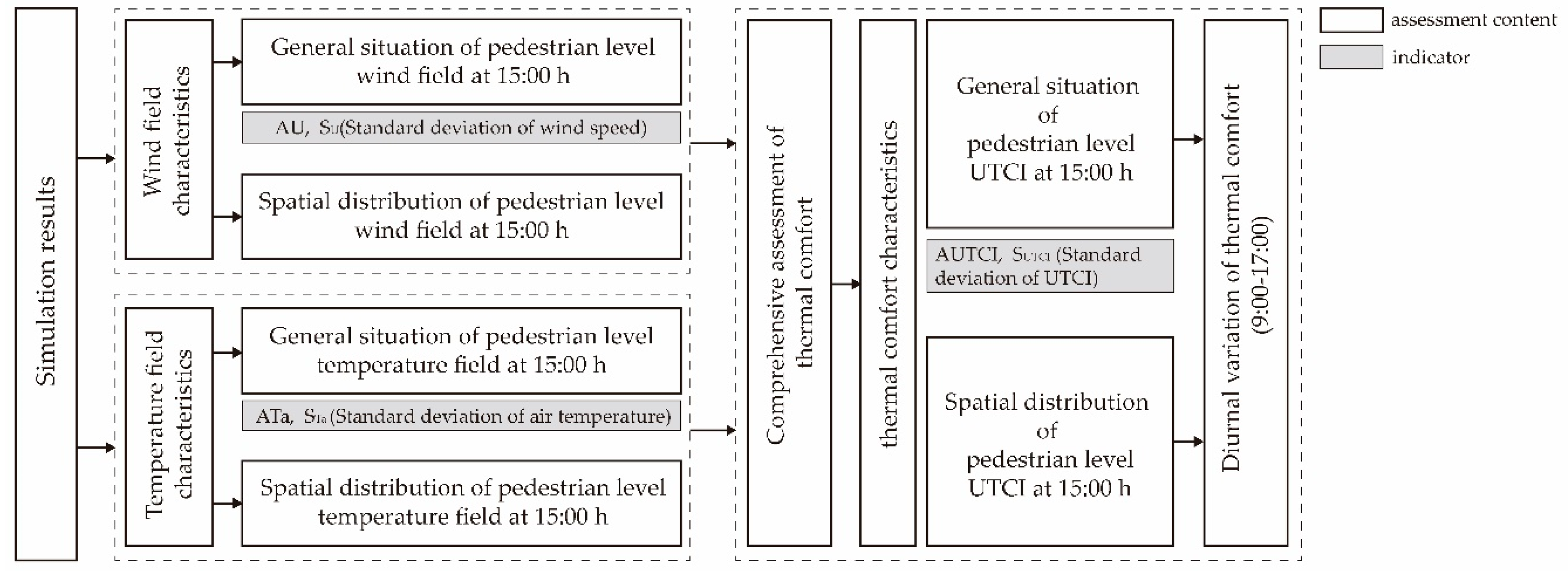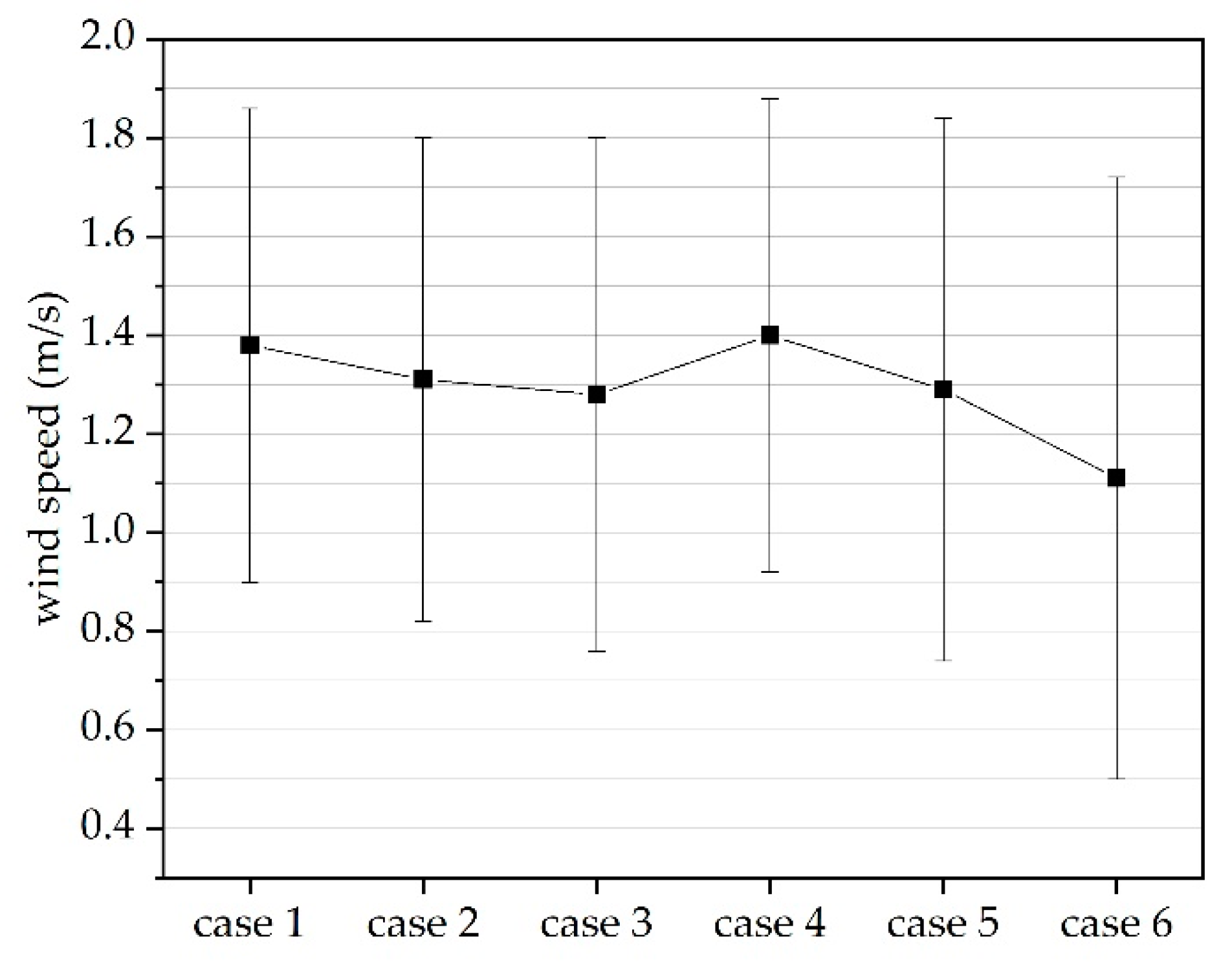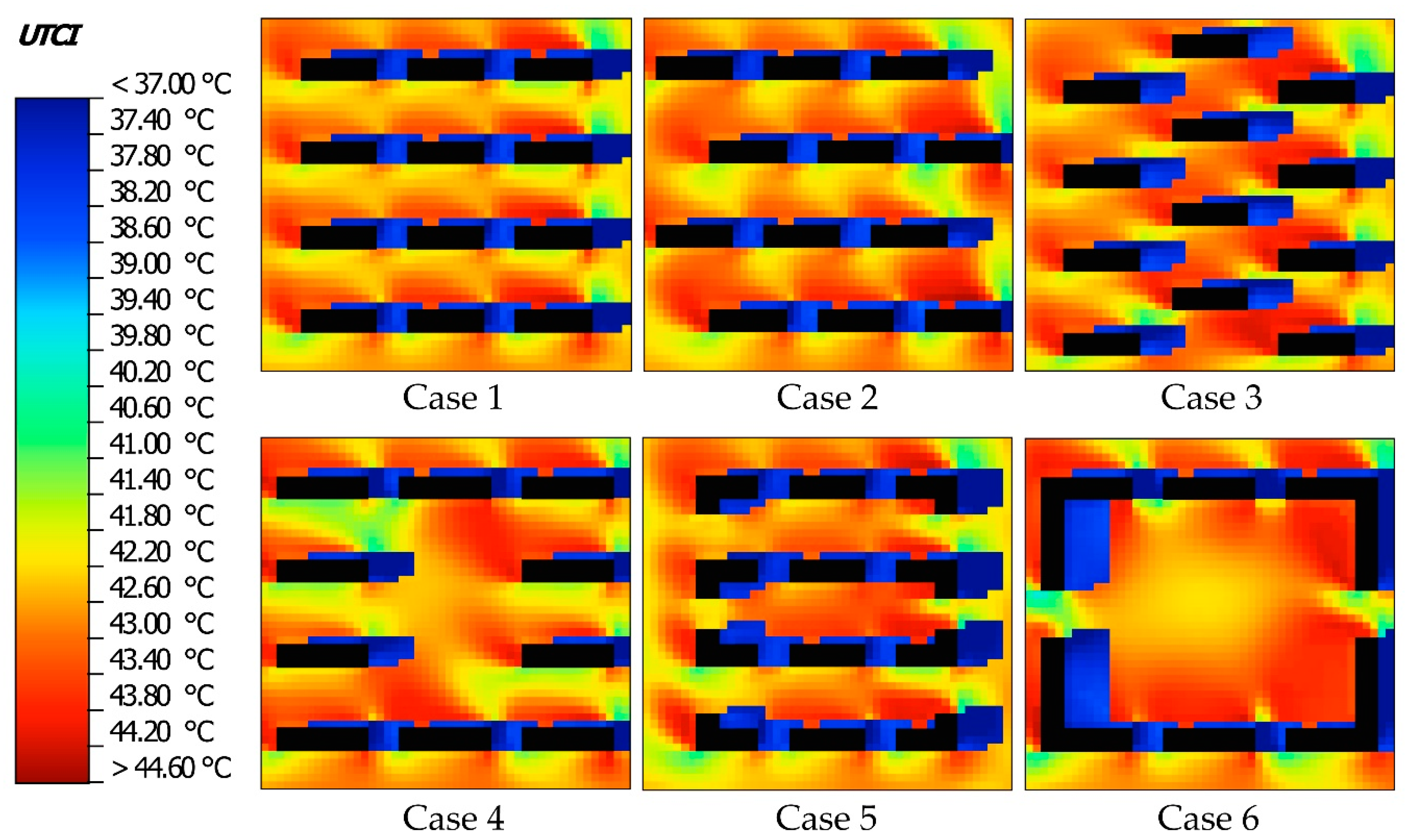Impact of Residential Building Layouts on Microclimate in a High Temperature and High Humidity Region
Abstract
:1. Introduction
2. Methods
2.1. Study Area
2.2. Methods
2.2.1. Construction of Simulation Models
2.2.2. Microclimate Simulation by ENVI-met
2.2.3. Assessment of Results
3. Results
3.1. Wind Field Characteristics
3.2. Temperature Field Characteristics
3.3. Thermal Comfort Characteristics
3.4. Diurnal Variation Characteristics of Thermal Comfort
4. Discussion
4.1. Effects of Building Layout on Microclimate
4.2. Building Layout Optimization Strategy
4.3. Further Study
5. Conclusions
Author Contributions
Funding
Conflicts of Interest
References
- Yang, Y.; Zhang, X.; Lu, X.; Hu, J.; Pan, X.; Zhu, Q.; Su, W. Effects of Building Design Elements on Residential Thermal Environment. Sustainability 2017, 10, 57. [Google Scholar] [CrossRef] [Green Version]
- Gao, Y.; Yao, R.; Li, B.; Turkbeyler, E.; Luo, Q.; Short, A. Field studies on the effect of built forms on urban wind environments. Renew. Energ. 2012, 46, 148–154. [Google Scholar] [CrossRef]
- Zhao, Q.; Sailor, D.J.; Wentz, E.A. Impact of tree locations and arrangements on outdoor microclimates and human thermal comfort in an urban residential environment. Urban For. Urban Green. 2018, 32, 81–91. [Google Scholar]
- Chan, A.L.S. Effect of adjacent shading on the thermal performance of residential buildings in a subtropical region. Appl. Energ. 2012, 92, 516–522. [Google Scholar] [CrossRef]
- Akbari, H.; Taha, H. The impact of trees and white surfaces on residential heating and cooling energy use in four Canadian cities. Energy 1992, 17, 141–149. [Google Scholar] [CrossRef]
- Yang, F.; Lau, S.S.Y.; Qian, F. Urban design to lower summertime outdoor temperatures: An empirical study on high-rise housing in Shanghai. Build. Environ. 2011, 46, 769–785. [Google Scholar] [CrossRef]
- Hong, B.; Lin, B. Numerical studies of the outdoor wind environment and thermal comfort at pedestrian level in housing blocks with different building layout patterns and trees arrangement. Renew. Energ. 2015, 73, 18–27. [Google Scholar] [CrossRef]
- Berkovic, S.; Yezioro, A.; Bitan, A. Study of thermal comfort in courtyards in a hot arid climate. Sol. Energ. 2012, 86, 1173–1186. [Google Scholar] [CrossRef]
- Chen, Z.H.; Wang, H.J.; Ren, G. Asymmetrical Change of Urban Heat Island Intensity in Wuhan, China. Adv. Clim. Chang. Res. 2007, 3, 282–286. [Google Scholar]
- Pan, J.; Zhao, X.; Chen, Z.; Wang, J. Provincial Climate Change Program: Hubei Case Study and Its Policy Implications. Adv. Climate Chang. Res. 2008, 4, 309–314. [Google Scholar]
- The Second C40 Urban Sustainable Development forum Held in Wuhan. Available online: http://www.hubei.gov.cn/xxbs/bmbs/sfgw1/201709/t20170925_1067458.shtml (accessed on 25 September 2017).
- Wuhan Peak Carbon Emissions Action Plan (2017–2022); Wuhan Municipal People’s Government: Wuhan, China, 2018.
- Yu, J.; Yang, C.; Tian, L. Low-energy envelope design of residential building in hot summer and cold winter zone in China. Energ. Build. 2008, 40, 1536–1546. [Google Scholar] [CrossRef]
- He, Y. Climatic Characteristics, Causes and Prediction of Mid-Summer High-Temperature in Wuhan. Meteorol. Sci. Tech. 2007, 35, 809–813. [Google Scholar]
- Yang, H.Q.; Chen, Z.H.; Xie, S.; Dian-Xiu, Y.E.; Gong, J. Quantitative assessment of impact of extreme high temperature in summer on excess mortality in Wuhan. J. Meteorol. Environ. 2013, 29, 140–143. [Google Scholar]
- Yuan, C.; Ren, C.; Ng, E. GIS-based surface roughness evaluation in the urban planning system to improve the wind environment – A study in Wuhan, China. Urban Clim. 2014, 10, 585–593. [Google Scholar] [CrossRef]
- Yu-qing, Y.I.; Teng-fei, L.; Wei-li, J.; Jian-wei, P.; Hui-chan, L.I.U.; Sai-guang, L. Characteristics and Evolution of the Summer Heat Island Effect in Wuhan City Group. Resour. Environ. Yangtze Basin 2015, 24, 1279–1285. [Google Scholar]
- Wuhan Municipal Bureau of Statistics. Wuhan Statistical Yearbook; China Statistics Press: Beijing, China, 2006–2018.
- Yu-jing, W. Study on Applicability of CFD Method in Wind Circumstance Simulation of Urban Space in Beijing. Master’s Thesis, Tsinghua University, Beijing, China, 2012. [Google Scholar]
- You, W.; Gao, Z.; Chen, Z.; Ding, W. Improving residential wind environments by understanding the relationship between building arrangements and outdoor regional ventilation. Atmosphere 2017, 8, 102. [Google Scholar] [CrossRef] [Green Version]
- Bruse, M.; Fleer, H. Simulating surface–plant–air interactions inside urban environments with a three dimensional numerical model. Environ. Model. Software 1998, 13, 373–384. [Google Scholar] [CrossRef]
- Jin, H.; Liu, Z.; Jin, Y.; Kang, J.; Liu, J. The Effects of Residential Area Building Layout on Outdoor Wind Environment at the Pedestrian Level in Severe Cold Regions of China. Sustainability 2017, 9, 2310. [Google Scholar] [CrossRef] [Green Version]
- Ketterer, C.; Matzarakis, A. Human-biometeorological assessment of heat stress reduction by replanning measures in Stuttgart, Germany. Landsc. Urban Plann. 2014, 122, 78–88. [Google Scholar] [CrossRef]
- Middel, A.; Häb, K.; Brazel, A.J.; Martin, C.A.; Guhathakurta, S. Impact of urban form and design on mid-afternoon microclimate in Phoenix Local Climate Zones. Landsc. Urban Plann. 2014, 122, 16–28. [Google Scholar] [CrossRef]
- Zhang, L.; Zhan, Q.; Lan, Y. Effects of the tree distribution and species on outdoor environment conditions in a hot summer and cold winter zone: A case study in Wuhan residential quarters. Build. Environ. 2018, 130, 27–39. [Google Scholar] [CrossRef]
- Kong, F.; Sun, C.; Liu, F.; Yin, H.; Jiang, F.; Pu, Y.; Cavan, G.; Skelhorn, C.; Middel, A.; Dronova, I. Energy saving potential of fragmented green spaces due to their temperature regulating ecosystem services in the summer. Appl. Energ. 2016, 183, 1428–1440. [Google Scholar] [CrossRef]
- Chen, L.; Ng, E. Simulation of the effect of downtown greenery on thermal comfort in subtropical climate using PET index: A case study in Hong Kong. Architect. Sci. Review 2013, 56, 297–305. [Google Scholar] [CrossRef]
- Bailey, B.H.; McDonald, S.L.; Bernadett, D.W.; Markus, M.J.; Elsholz, K.V. Wind Resource Assessment Handbook: Fundamentals for Conducting a Successful Monitoring Program; AWS Scientific: New York, NY, USA, 1997. [Google Scholar]
- Broede, P.; Blazejczyk, K.; Fiala, D.; Havenith, G.; Holmer, I.; Jendritzky, G.; Kuklane, K.; Kampmann, B. The Universal Thermal Climate Index UTCI Compared to Ergonomics Standards for Assessing the Thermal Environment. Ind. Health 2013, 51, 16–24. [Google Scholar] [CrossRef] [Green Version]
- Blazejczyk, K.; Epstein, Y.; Jendritzky, G.; Staiger, H.; Tinz, B. Comparison of UTCI to selected thermal indices. I. J. Biometeorol. 2012, 56, 515–535. [Google Scholar] [CrossRef] [Green Version]
- Yuan, C.; Ng, E. Building porosity for better urban ventilation in high-density cities – A computational parametric study. Build. Environ. 2012, 50, 176–189. [Google Scholar] [CrossRef]
- Moonen, P.; Dorer, V.; Carmeliet, J. Evaluation of the ventilation potential of courtyards and urban street canyons using RANS and LES. J.Wind Eng. Ind. Aerodyn. 2011, 99, 414–423. [Google Scholar] [CrossRef]
- Lu, M.; Hou, T.; Fu, J.; Wei, Y. The Effects of Microclimate Parameters on Outdoor Thermal Sensation in Severe Cold Cities. Sustainability 2019, 11, 1572. [Google Scholar] [CrossRef] [Green Version]
- Zheng, Y.; Yin, J.; Wu, R.; Ye, D. Applicability of Universal Thermal Climate Index to Thermal Comfort Forecast. J. Appl. Meteorol. Sci. 2010, 21, 709–715. [Google Scholar]
- Park, S.; Tuller, S.E.; Jo, M. Application of Universal Thermal Climate Index (UTCI) for microclimatic analysis in urban thermal environments. Landsc. Urban Plann. 2014, 125, 146–155. [Google Scholar] [CrossRef]
- Bröde, P.; Krüger, E.; Rossi, F.; Fiala, D. Predicting urban outdoor thermal comfort by the Universal Thermal Climate Index UTCI-a case study in Southern Brazil. I. J. Biometeorol. 2011, 56, 471–480. [Google Scholar] [CrossRef] [PubMed]












| Model domain | Size of grid cells (∆x, ∆y, ∆z) | 4, 4, 3 (0.6 for the bottom grid) |
| Number of grid cells (∆x, ∆y, ∆z) | 179, 179, 29 | |
| Timing | Start simulation at day (DD.MM.YYYY) | 21.07.2018 |
| Start simulation at time (HH:MM:SS) | 06:00:00 | |
| Total simulation at time (h) | 42 | |
| LBC types | LBC for T and q | Forced |
| LBC for TKE | Forced | |
| Meteorological data | Wind speed measured at 10 m (m/s) | 2.2 |
| Wind direction | 135° (southeast) | |
| Roughness length at measurement site | 0.1 | |
| Initial temperature of atmosphere (K) | 301.51 | |
| Specific humidity at model top (2500 m, g/kg) | 7 | |
| Relative humidity in 2 m height (%) | 88 |
| UTCI (℃) Range | Stress Category |
|---|---|
| Above +46 | Extreme heat stress |
| +38 to +46 | Very strong heat stress |
| +32 to +38 | Strong heat stress |
| +26 to +32 | Moderate heat stress |
| +9 to +26 | No thermal stress |
| +9 to 0 | Slight clod stress |
| 0 to −13 | Moderate clod stress |
| −13 to −27 | Strong clod stress |
| −27 to −40 | Very strong clod stress |
| Below −40 | Extreme clod stress |
| Wind Speed Characteristics | Wind Speed (m/s) | Relative Frequency (%) | |||||
|---|---|---|---|---|---|---|---|
| Case 1 | Case 2 | Case 3 | Case 4 | Case 5 | Case 6 | ||
| Stagnant | u < 0.3 | 2.65 | 2.71 | 3.46 | 1.35 | 4.27 | 11.04 |
| Poor | 0.6 > u ≥ 0.3 | 3.73 | 4.71 | 6.01 | 5.41 | 6.44 | 13.15 |
| Low | 1.0 > u ≥ 0.6 | 16.77 | 18.89 | 21.05 | 14.94 | 20.51 | 16.94 |
| Satisfactory | 1.3 > u ≥ 1.0 | 14.94 | 23.05 | 22.40 | 15.10 | 19.59 | 22.29 |
| Good | u ≥ 1.3 | 61.90 | 50.65 | 47.08 | 63.20 | 49.19 | 36.58 |
| Air Temperature Characteristics | Air Temperature (℃) | Relative Frequency (%) | |||||
|---|---|---|---|---|---|---|---|
| Case 1 | Case 2 | Case 3 | Case 4 | Case 5 | Case 6 | ||
| High temperature area | Ta ≥ 33 | 40.02 | 31.22 | 29.25 | 40.50 | 31.87 | 17.64 |
| Medium temperature area | 33 > Ta ≥ 32.5 | 57.81 | 62.12 | 55.36 | 58.04 | 40.87 | 40.35 |
| Low temperature area | Ta < 32.5 | 3.75 | 6.66 | 15.38 | 1.46 | 27.26 | 42.00 |
© 2020 by the authors. Licensee MDPI, Basel, Switzerland. This article is an open access article distributed under the terms and conditions of the Creative Commons Attribution (CC BY) license (http://creativecommons.org/licenses/by/4.0/).
Share and Cite
Jiang, Y.; Wu, C.; Teng, M. Impact of Residential Building Layouts on Microclimate in a High Temperature and High Humidity Region. Sustainability 2020, 12, 1046. https://doi.org/10.3390/su12031046
Jiang Y, Wu C, Teng M. Impact of Residential Building Layouts on Microclimate in a High Temperature and High Humidity Region. Sustainability. 2020; 12(3):1046. https://doi.org/10.3390/su12031046
Chicago/Turabian StyleJiang, Yingjie, Changguang Wu, and Mingjun Teng. 2020. "Impact of Residential Building Layouts on Microclimate in a High Temperature and High Humidity Region" Sustainability 12, no. 3: 1046. https://doi.org/10.3390/su12031046





